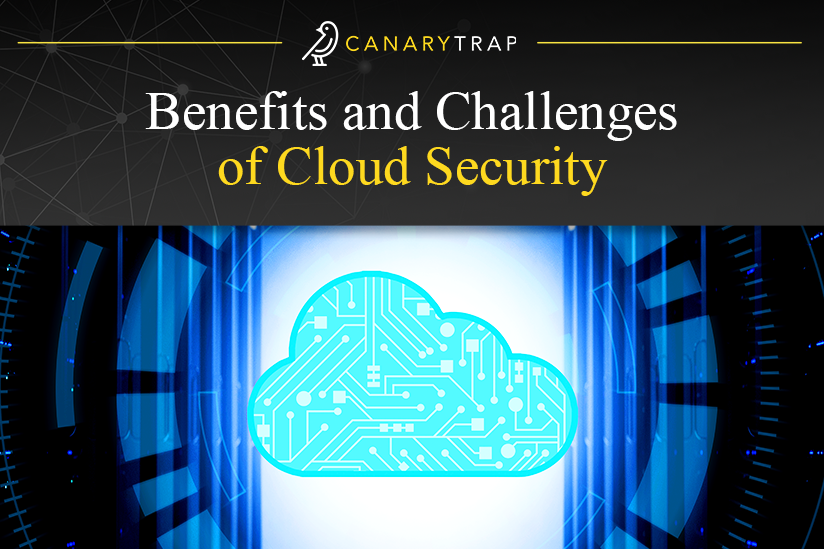Benefits and Challenges of Cloud Security
- July 14, 2023
- Canary Trap
The state of today’s digital landscape has made organizations face the dual challenge of protecting sensitive data and optimizing operational efficiency. That’s how the cloud has emerged as a transformative solution, offering scalability, flexibility, and cost-effectiveness. However, concerns about cloud security and the potential risks associated with storing data in the cloud persist. In this comprehensive blog post, we will delve into the question: “How secure is the cloud?” by exploring the benefits, challenges, real-world examples, best practices, and strategies for cloud adoption. We will provide actionable insights to mitigate risks, enhance data protection, and maximize the potential of cloud computing for organizations.
Understanding Cloud Security
Cloud security refers to the measures and practices implemented to protect data, applications, and infrastructure hosted in the cloud. It involves a combination of technical controls, policies, and procedures to ensure confidentiality, integrity, and availability of data. While some organizations may have initial reservations about the security of cloud services, it is important to note that reputable cloud service providers invest heavily in robust security measures.
According to Google, “cloud security works to provide storage and network protection against internal and external threats, access management, data governance and compliance, and disaster recovery. Cloud computing has become the technology of choice for companies looking to gain the agility and flexibility needed to accelerate innovation and meet the expectations of today’s modern consumers.”
What Are the Benefits of Using the Cloud?
- Robust Infrastructure and Security Expertise
Trusted cloud service providers, such as Amazon Web Services (AWS) and Microsoft Azure, invest significant resources in building secure infrastructure and maintaining a strong security posture. They have dedicated teams of security professionals who constantly monitor and enhance their security controls. By leveraging the cloud, organizations can tap into this expertise and benefit from state-of-the-art security measures that are often beyond their own capabilities.
- Data Encryption and Access Controls
Cloud providers offer robust encryption mechanisms to protect data at rest and in transit. They implement encryption technologies, such as SSL/TLS protocols, to secure data transmission over networks. Organizations can also leverage encryption tools provided by the cloud provider or implement their own encryption solutions for an added layer of data protection.
IAM (Identity and Access Management) is another critical aspect of cloud security. Organizations can define granular access controls, implement multi-factor authentication, and manage user privileges to ensure that only authorized individuals have access to sensitive data and resources.
- Compliance and Auditing
Cloud service providers adhere to stringent compliance standards and undergo regular audits to ensure that their infrastructure and services meet industry-specific regulations. Whenever organizations can leverage compliant cloud services, they can benefit from built-in security controls and documentation that facilitate their own compliance requirements.
- Shared Responsibility Model
It is important for organizations to understand the shared responsibility model when it comes to cloud security. Cloud service providers (CSP) are responsible for securing the underlying infrastructure, physical security, and maintaining the availability of their services. On the other hand, organizations are responsible for securing their data, managing user access, and implementing additional security controls based on their specific requirements.
As stated in an article published by Dataconomy, “failure to properly secure customer-owned resources can lead to security incidents, data breaches, and other problems. It is therefore important for customers to take their security responsibilities seriously and to work closely with their CSP to ensure that their cloud environment is secure.”
Advantages & Real World Examples of Cloud Adoption
- Scalability and Flexibility
The cloud provides organizations with the ability to scale their infrastructure and resources dynamically based on their requirements. For instance, Netflix, the renowned streaming service, leverages the cloud to handle massive streaming demands during popular TV show releases, ensuring uninterrupted user experiences and seamless scalability.
- Cost Savings
Cloud adoption can lead to significant cost savings for organizations, as businesses can avoid upfront investments in hardware, software licenses, and maintenance costs. For instance, Airbnb, a leading accommodation marketplace, utilizes the cloud to scale its infrastructure without the need to build and maintain physical data centers, allowing them to focus resources on improving user experience and expanding their services. This cost-effective approach is what has fueled their rapid growth.
- Collaboration and Productivity
Cloud-based collaboration tools empower teams to work seamlessly across locations and time zones. Platforms like Microsoft Office 365 and Google Workspace provide document sharing, real-time editing, and communication features. Companies like Slack and Trello, for example, leverage these tools to enhance productivity and enable effective collaboration among remote teams, resulting in streamlined workflows and improved efficiency.
Understanding the Challenges of the Cloud
While cloud computing offers immense benefits, organizations must be mindful of the unique security challenges it presents. Let’s delve deeper into some of these challenges:
- Data Breach Risks
While cloud service providers invest heavily in security measures, data breaches can still occur. Organizations must ensure proper security controls, including encryption, access management, and ongoing monitoring, to protect their data from unauthorized access.
A notable example, as detailed in an article in The Register, is the 2019 Capital One data breach in the United States, where a misconfigured cloud server exposed sensitive customer information due to a vulnerability in the cloud infrastructure. This incident underscores the importance of rigorous security measures and ongoing vigilance.
- Dependency on Internet Connectivity
Cloud services heavily rely on internet connectivity. Organizations should consider backup connectivity options and develop contingency plans to mitigate the impact of service disruptions caused by internet outages or network issues.
Multiple outages in Microsoft’s Cloud services and the Oracle Cloud Infrastructure earlier this year “are a reminder of the importance of site engineering for systems administrators whose businesses rely on cloud-based mission critical applications,” as detailed in a report by Network World.
- Compliance and Data Governance
Organizations operating in regulated industries must navigate compliance requirements when storing data in the cloud. Healthcare providers must adhere to the Health Insurance Portability and Accountability Act (HIPAA), while financial institutions must comply with the Payment Card Industry Data Security Standard (PCI DSS). Cloud adoption requires careful consideration of data residency, data handling, and compliance obligations to maintain regulatory compliance and protect sensitive information.
What Strategies Can Be Used to Enhance Cloud Security?
- Encryption and Data Protection
Implementing strong encryption mechanisms for data at rest and in transit adds an extra layer of protection. Organizations should employ robust encryption algorithms, securely manage encryption keys, and regularly update encryption protocols to ensure data confidentiality and integrity. Encryption, combined with strict access controls, reduces the risk of data breaches and unauthorized access.
- Identity and Access Management (IAM)
Implementing IAM practices helps organizations enforce appropriate access controls and minimize the risk of unauthorized access to cloud resources. This involves implementing strong authentication mechanisms, such as multi-factor authentication (MFA), and defining granular access policies to limit user privileges based on their roles and responsibilities. Regularly reviewing and revoking unnecessary access privileges further reduces the attack surface and enhances overall security.
- Continuous Monitoring and Threat Intelligence
Organizations should leverage security monitoring tools, such as Security Information and Event Management (SIEM) solutions, to detect and respond to security incidents promptly. SIEM platforms collect and analyze security event data from various sources, providing real-time insights into potential threats and vulnerabilities. With the use of threat intelligence feeds, organizations can stay informed about emerging risks and proactively work to mitigate them.
- Employee Training and Awareness
Human error remains a significant contributor to security breaches. Comprehensive security awareness training programs educate employees about safe computing practices, recognizing phishing attempts, and adhering to security policies. Regularly updated training modules and simulated phishing exercises help instill a security-conscious culture within the organization, which reduces the likelihood of successful attacks.
Best Practices for Secure Cloud Adoption
Cloud security is an ongoing effort that requires a proactive and multi-faceted approach from organizations in order to protect their data. The following are some best practices that can be employed to reduce risks, prevent unauthorized access, and ensure the confidentiality and integrity of their digital assets:
- Conducting thorough risk assessments and identifying critical assets.
- Implementing strong access controls and user authentication mechanisms.
- Regularly monitoring and analyzing logs and security events to detect anomalies and potential security incidents.
- Implementing encryption for data protection, both at rest and in transit.
- Regularly patching and updating systems and applications to address vulnerabilities.
- Implementing a robust backup and disaster recovery strategy to ensure data availability and resilience.
- Educating employees on security best practices and raising awareness about the potential risks associated with cloud usage.
In Conclusion
The question of “How secure is the cloud?” is a valid concern for organizations considering cloud adoption. However, by understanding the shared responsibility model, leveraging reputable cloud service providers, and implementing best practices, organizations can enhance their security measures and mitigate potential risks.
The cloud offers numerous benefits, including robust infrastructure, expertise, compliance adherence, and scalability. As organizations continue to embrace digital transformation, they must strike a balance between innovation and security to protect their digital assets and maintain a competitive edge in an evolving threat landscape, and harnessing the power of the cloud while prioritizing security is crucial for maintaining a resilient and protected digital environment.
SOURCES:
- https://cloud.google.com/learn/what-is-cloud-security
- https://dataconomy.com/2023/05/08/shared-responsibility-model-in-cloud-computing/
- https://www.theregister.com/2022/06/20/captial_one_wire_fraud/
- https://www.networkworld.com/article/3688509/oracle-outages-serve-as-warning-for-companies-relying-on-cloud-technology.html

